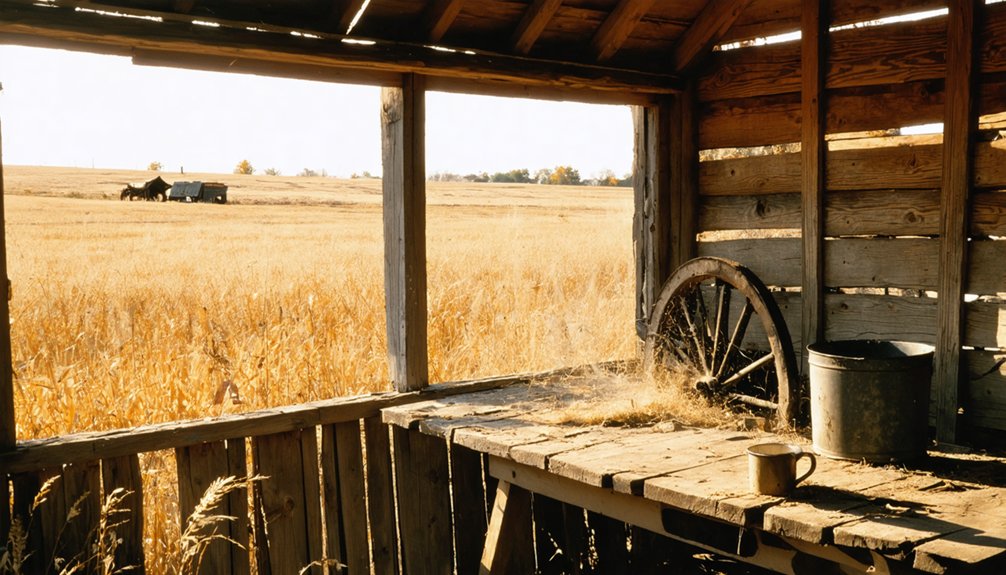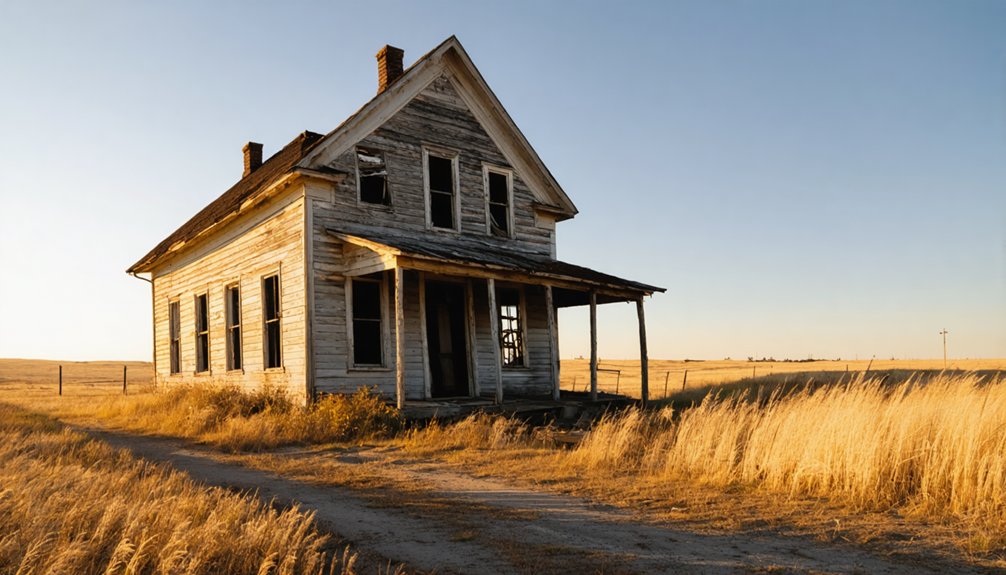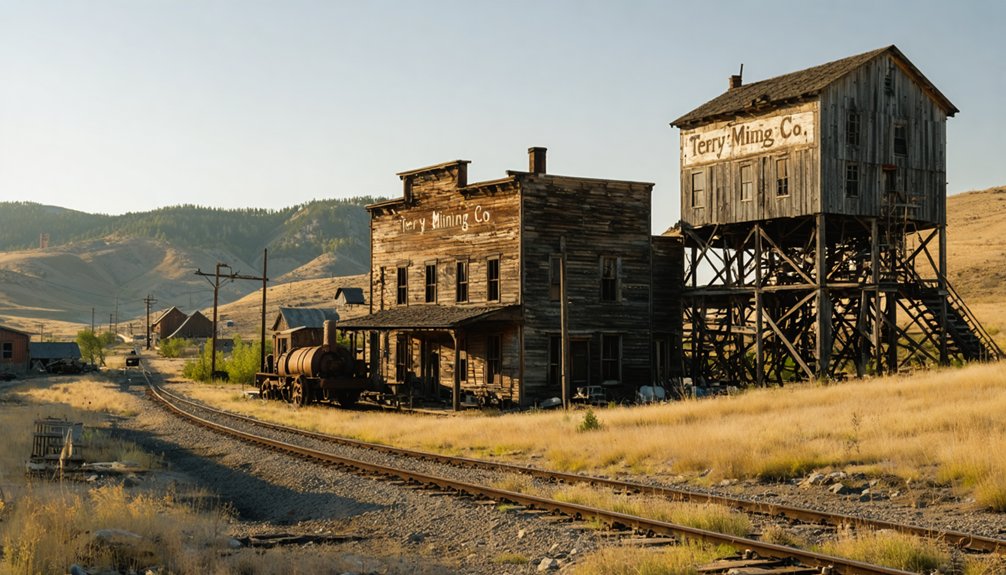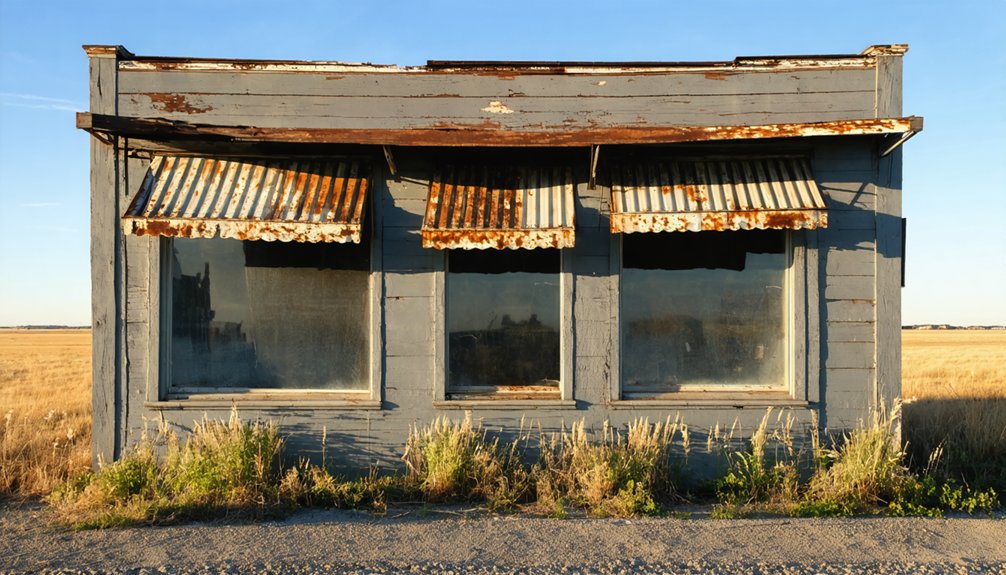You’ll discover Terry nestled at 5,700 feet in South Dakota’s Black Hills, where gold-bearing formations sparked a mining boom in the 1890s. The Golden Reward Mining Company transformed this mountain settlement into a thriving community of 1,200 residents by 1904, complete with railways and mills. By the 1930s, depleted ore deposits and harsh mountain conditions led to Terry’s abandonment, though its rich history of resilient miners, frontier figures like Calamity Jane, and innovative mining operations still echoes through the hills.
Key Takeaways
- Terry was established as a gold mining settlement in the 1890s at Terry Peak’s base, reaching its peak population of 1,200 residents by 1904.
- The Golden Reward Mine, established in 1887, was the town’s economic backbone, producing 280,000 ounces of gold between 1989-1996.
- Mining operations declined in the late 1920s due to depleted high-grade ores, leading to mass exodus in the early 1930s.
- The removal of the Spearfish railroad line in 1933 and post office closure in 1929 accelerated Terry’s transformation into a ghost town.
- Terry’s abandoned structures and mining remnants stand as testament to the boom-and-bust cycle of Black Hills mining communities.
The Rise of Terry’s Mining Empire
When gold-bearing formations were discovered in the early 1890s, Terry quickly emerged as a prominent mining settlement in South Dakota’s Black Hills region.
You’ll find that two powerhouse operations – the Welcome mine (later part of the Horseshoe group) and the Golden Reward company – dominated the landscape, with their claims stretching across 3,400 acres beneath the townsite.
Terry’s infrastructure became remarkably robust, featuring two narrow-gauge railways that connected to the Burlington line, positioning the town as a crucial hub between Lead and Deadwood. The town’s bustling church steeple stood as a distinctive landmark against the mining backdrop.
Mining innovations flourished here, with both Horseshoe and Golden Reward embracing advanced metallurgical techniques. The Golden Reward Chlorination plant was processing 25 tons of ore daily by 1890, while the Horseshoe company operated a cutting-edge cyanide plant above the town, showcasing Terry’s technological leadership in the mining industry. The town reached its zenith with over 1,200 residents by 1904.
Life at 5,700 Feet: A Town in the Clouds
Perched high in South Dakota’s Black Hills at 5,700 feet, Terry faced unique challenges that shaped daily life in this mountain settlement. You’d have found yourself adapting to dramatic mountain weather patterns, where temperatures rarely climbed above 75°F even in summer, and winter snowfall could pile up beyond 100 inches at nearby Terry Peak. Strong winds constantly swept through the area, with gusts reaching 40 mph during stormy periods.
The region was known for experiencing remarkably warm winters, as evidenced by the record-breaking January temperatures in nearby Spearfish.
Life demanded community resilience as residents banded together to survive the harsh conditions. You’d have needed to plan carefully for long winters, storing food supplies and ensuring your home had proper insulation against the biting cold.
The thin air made physical labor more demanding, especially for miners, while unpredictable weather and icy roads often isolated the town. Still, locals found ways to thrive, turning to skiing and winter tourism to sustain their mountain economy.
Golden Reward Mine and Railroad Development
Deep beneath Terry’s mountain slopes, the Golden Reward Mine emerged as a crucial force in Black Hills mining history after its establishment in 1887.
You’ll find it nestled at Terry Peak’s base, where rich flat ore bodies sparked a mining revolution that would shape the region’s destiny. Between 1989 and 1996, the mine yielded an impressive 280,000 ounces of gold.
The mine’s gold extraction methods evolved dramatically, pioneering cyanide heap leaching to replace older mercury and chlorine processes.
You can trace the railroad’s impact through two narrow-gauge systems – Northwestern and Burlington – that made Terry their terminus.
These essential rail lines transformed ore transportation, connecting the mining operation to the Golden Reward mill in Deadwood.
Daily Life in a Black Hills Mining Settlement
You’ll find the harsh realities of daily life in Terry reflected in the tight-knit clusters of miners’ homes perched at over 5,700 feet, where families endured brutal Black Hills winters and the constant anxiety of underground accidents.
Your average mining family’s existence revolved around the grueling schedule of shift work, with wives maintaining households through challenging conditions while children grew up in a community defined by the sounds and rhythms of ore processing. The discovery of rich deposits of gold and silver in the region drove waves of adventurers to seek their fortunes through individual mining claims in the 1870s and 1880s. Many miners relied on traditional placer mining techniques to extract loose gold pieces mixed with soil and rocks from creek beds.
While the town offered basic amenities like a church and general stores, the mining families’ survival depended heavily on mutual support and resilience in this remote, high-elevation settlement.
Mining Families’ Living Conditions
As Terry’s population swelled with fortune-seeking miners in the late 1800s, families carved out modest lives in hastily constructed wooden homes clustered near the mines and rail lines.
You’d find these simple dwellings packed tightly together, creating neighborhoods where privacy was scarce but community bonds grew strong. Housing conditions were basic – most homes lacked modern plumbing and electricity, forcing residents to haul water from local sources.
Family dynamics adapted to these challenging circumstances. To make ends meet, many households took in boarders or shared space with extended family members. At its peak, the town housed nearly 1,000 residents who contributed to its bustling atmosphere.
Since mining companies owned most of the land, you couldn’t count on staying put; families lived with the constant possibility of displacement as mining operations shifted and evolved.
Daily Survival Above 5,700ft
Living at 5,700 feet above sea level brought unique challenges for Terry’s hardy residents. You’d have needed solid survival strategies to weather the harsh Black Hills environment, where winter storms could isolate the community for days.
The altitude challenges meant you’d tire more easily while working the mines, and everyday tasks required extra effort as your body adapted to the thin air. Mining families had to be resilient like those in Homestake Mining Company, which became one of the region’s most prominent operations. The rush began after Custer’s expedition discovered gold in 1874, bringing waves of prospectors to the area.
You couldn’t just rely on regular supply runs – you’d have to stockpile essentials and develop local resources. The Burlington rail line was your lifeline, but when weather cut off access, you’d turn to community support.
The mining families learned to preserve food, maintain heat sources, and share resources. Your success in Terry meant mastering both the demands of mining work and the art of high-elevation living.
Calamity Jane’s Final Days

During the sweltering summer of 1903, Calamity Jane spent her final days at the Calloway Hotel in Terry, South Dakota, where she succumbed to inflammation of the bowels and pneumonia at age 51.
Her body, ravaged by years of heavy drinking, was dressed in an uncharacteristic white dress for her final photograph, a stark contrast to her preferred men’s attire.
In death, they clothed the hardened frontierswoman in pristine white, denying her the masculine garments she’d chosen throughout life.
You’ll find that Calamity Jane’s legacy lives on through her final wishes, which the Society of Black Hills Pioneers honored faithfully.
F.X. Smith transported her remains to Deadwood, where she was buried beside Wild Bill Hickok in Mount Moriah Cemetery.
She’d asked that her trunk be sent to Lottie Stacy in Belle Fourche, suggesting strained family ties even as local newspaper editor W.R. Monkman worked to fulfill her last requests.
The Decline and Abandonment
Terry’s decline began in earnest during the late 1920s when the mining operations started yielding diminishing returns, causing many of the 1,200 residents to seek opportunities elsewhere.
You’d have witnessed a dramatic exodus throughout the early 1930s, particularly after the removal of the Spearfish railroad line in 1933 cut off crucial transportation access.
The final blow came as open-pit mining operations literally consumed what remained of the town, leaving behind only scattered foundations and memories of Terry’s once-bustling mining community.
Population Exodus Timeline
While the Black Hills mining town of Terry reached its zenith with 1,200 residents in 1904, its population began a steady decline that would span several decades.
You’ll find the first major signs of the exodus emerging in the 1920s, when shifting community dynamics forced adaptations like converting boarding houses into schools. The town’s heartbeat weakened further with the post office’s closure in 1929, marking a significant turning point in Terry’s story.
The 1930s and 1940s saw an accelerated departure as mines closed and jobs disappeared.
Population statistics show a dramatic drop as families sought opportunities elsewhere, leaving behind empty homes and shuttered businesses.
Economic Downfall and Mining
As the lucrative high-grade oxidized ores began depleting in Terry’s mines, the town’s economic foundation started crumbling beneath its feet.
The mines’ shift to low-grade “blue ores” brought insurmountable economic challenges, as existing mining technology couldn’t efficiently extract gold from these complex deposits. You’d have seen the Golden Reward and Horseshoe mines struggle with rising costs and diminishing returns, despite their attempts at technological innovation.
The town’s isolation didn’t help either – high freight rates to Deadwood’s processing facilities cut deeply into profits.
Labor disputes and union activities further strained the mining operations, while inadequate transportation infrastructure made it increasingly difficult to sustain profitable operations.
What Remains Today

Little remains of the once-bustling mining town of Terry, South Dakota today.
You’ll find the site on private mining company land, where nature has reclaimed most traces of Terry’s historical significance. The landscape has transformed into barren pasture, with even the railroad infrastructure that once served this thriving community completely vanished.
- No standing structures remain above ground, though you might spot scattered foundation remnants if you look closely.
- The cemetery’s existence is uncertain, with no confirmed visible markers or public access available.
- Terry’s geography is now characterized by undeveloped land, possibly showing faint traces of old mining pits and tailings.
The site’s inaccessibility and private ownership status means you can’t freely explore this piece of South Dakota’s mining heritage without proper permission.
Terry’s Place in Black Hills History
Terry’s origins are deeply intertwined with the economic boom of the Black Hills gold rush, making it a significant chapter in South Dakota’s mining heritage.
You’ll find that during its peak in 1893, Terry stood as one of Lawrence County’s most substantial settlements, housing about 1,000 residents and serving as an essential Burlington rail stop.
The town’s economic impact was remarkable, with its Golden Reward Mining Company ranking as the second most productive operation in the Black Hills, trailing only the legendary Homestake Mine.
By 1901, Golden Reward had contributed $1.2 million to the region’s impressive $8 million gold output.
Unlike many temporary mining camps, Terry established itself as a formidable community with lasting infrastructure, though its fate remained tied to the mine’s success until operations ceased in 1918.
Legacy of a Vanished Mining Town

Despite its complete physical disappearance, the legacy of Terry lives on as a quintessential example of the Black Hills’ boom-and-bust mining era.
You’ll find its story woven into the fabric of South Dakota’s mining heritage, where advanced mining techniques eventually consumed the very town they helped build. While the physical structures are gone, Terry’s tale offers valuable insights into the resilience of frontier communities and the price of progress.
- The town’s transformation from a thriving community of 1,200 to an abandoned mining site demonstrates the impermanence of boom towns.
- Strong community bonds formed through churches, unions, and shared mining work defined Terry’s social character.
- Historical photographs and markers preserve Terry’s memory, though you can’t visit the actual site on today’s private mining land.
Frequently Asked Questions
What Specific Diseases or Health Issues Affected Terry’s Mining Population?
You’d have encountered devastating tuberculosis outbreaks in Terry’s mines, where dust-filled lungs made workers vulnerable. Mining accidents, respiratory diseases, and mercury poisoning regularly claimed lives in your community.
Were There Any Known Conflicts Between Mining Companies and Native Americans?
You’ll find significant mining disputes erupted as companies violated the 1868 Fort Laramie Treaty, causing cultural impact through illegal mining on Sioux lands and desecration of sacred sites near the Black Hills.
How Did Terry Residents Get Their Food and Water Supplies?
You’d get your water from local springs and wells near Terry Peak, while relying on railroad-delivered supplies, preserved foods, and limited farming techniques. Hunting and foraging supplemented your family’s basic provisions.
What Types of Entertainment and Social Activities Existed in Terry?
You’d find miners socializing at community gatherings, sharing stories at local saloons, hiking the Black Hills, hunting game, attending railroad celebrations, and joining town meetings for both business and pleasure.
Did Any Major Crimes or Notable Lawmen Shape Terry’s History?
You won’t find records of notable criminals or significant law enforcement figures in Terry’s history. The town’s mining-focused economy and brief existence left little documentation of major crimes or lawmen.
References
- https://www.sdpb.org/arts-life/vanished-south-dakota-in-the-moment
- https://www.youtube.com/watch?v=Glucs_Rq8Xs
- https://www.youtube.com/watch?v=Qt1KIdgSX4Q
- https://westernmininghistory.com/towns/south-dakota/terry/
- https://hpr1.com/index.php/feature/culture/festivals-of-history-in-south-dakota
- https://en.wikipedia.org/wiki/List_of_ghost_towns_in_South_Dakota
- https://explore.digitalsd.org/digital/collection/WPGhosttown/id/7006
- https://lawrencecountyhistory.blogspot.com/2011/03/another-glimpse-of-past.html
- https://www.sdpb.org/rural-life-and-history/History-of-heap-leaching-at-the-Golden-Reward-Mine
- https://powderhousepass.com/our-development/history-of-the-land



